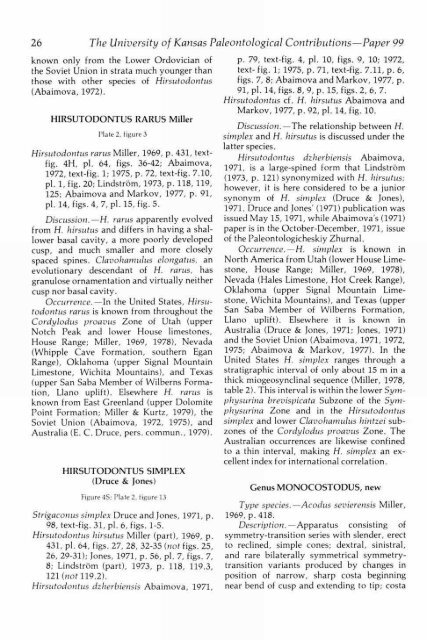View - KU ScholarWorks - University of Kansas
View - KU ScholarWorks - University of Kansas
View - KU ScholarWorks - University of Kansas
Create successful ePaper yourself
Turn your PDF publications into a flip-book with our unique Google optimized e-Paper software.
26 The <strong>University</strong> <strong>of</strong> <strong>Kansas</strong> Paleontological Contributions-Paper 99<br />
known only from the Lower Ordovician <strong>of</strong><br />
the Soviet Union in strata much younger than<br />
those with other species <strong>of</strong> Hirsutodontus<br />
(Abaimova, 1972).<br />
HIRSUTODONTUS RARUS Miller<br />
Plate 2, figure 3<br />
Hirsutodontus rarus Miller, 1969, p. 431, textfig.<br />
4H, pl. 64, figs. 36-42; Abaimova,<br />
1972, text-fig. 1; 1975, p. 72, text-fig. 7.10,<br />
pl. 1, fig. 20; LindstrOm, 1973, p. 118, 119,<br />
125; Abaimova and Markov, 1977, P. 91,<br />
pl. 14, figs. 4, 7, pl. 15, fig. 5.<br />
Discussion. - H. rarus apparently evolved<br />
from I-I. hirsutus and differs in having a shallower<br />
basal cavity, a more poorly developed<br />
cusp, and much smaller and more closely<br />
spaced spines. Clavoltamulus elongatus, an<br />
evolutionary descendant <strong>of</strong> H. rarus, has<br />
granulose ornamentation and virtually neither<br />
cusp nor basal cavity.<br />
Occurrence. -In the United States, Hirsutodontus<br />
rarus is known from throughout the<br />
Cordylodus proavus Zone <strong>of</strong> Utah (upper<br />
Notch Peak and lower House limestones,<br />
House Range; Miller, 1969, 1978), Nevada<br />
(Whipple Cave Formation, southern Egan<br />
Range), Oklahoma (upper Signal Mountain<br />
Limestone, Wichita Mountains), and Texas<br />
(upper San Saba Member <strong>of</strong> Wilberns Formation,<br />
Llano uplift). Elsewhere H. rams is<br />
known from East Greenland (upper Dolomite<br />
Point Formation; Miller & Kurtz, 1979), the<br />
Soviet Union (Abaimova, 1972, 1975), and<br />
Australia (E. C. Druce, pers. commun., 1979).<br />
HIRSUTODONTUS SIMPLEX<br />
(Druce & Jones)<br />
Figure 4S; Plate 2, figure 13<br />
Strigaconus simplex Druce and Jones, 1971, P.<br />
98, text-fig. 31, pl. 6, figs. 1-5.<br />
Hirsutodontus hirsutus Miller (part), 1969, p.<br />
431, pl. 64, figs. 27, 28, 32-35 (not figs. 25,<br />
26, 29-31); Jones, 1971, p. 56, pl. 7, figs. 7,<br />
8; Lindstriim (part), 1973, p. 118, 119.3,<br />
121 (not 119.2).<br />
Hirsutodon tus dzherbiensis Abaimova, 1971,<br />
p. 79, text-fig. 4, pl. 10, figs. 9, 10; 1972,<br />
text- fig. 1; 1975, p. 71, text-fig. 7.11, p. 6,<br />
figs. 7, 8; Abaimova and Markov, 1977, p.<br />
91, pl. 14, figs. 8, 9, p. 15, figs. 2, 6, 7.<br />
Hirsutodontus cf. H. hirsutus Abaimova and<br />
Markov, 1977, p. 92, pl. 14, fig. 10.<br />
Discussion. -The relationship between H.<br />
simplex and H. hirsutus is discussed under the<br />
latter species.<br />
Hirsutodontus dzherbiensis Abaimova,<br />
1971, is a large-spined form that LindstrOm<br />
(1973, p. 121) synonymized with H. hirsutus;<br />
however, it is here considered to be a junior<br />
synonym <strong>of</strong> H. simplex (Druce & Jones),<br />
1971. Druce and Jones' (1971) publication was<br />
issued May 15, 1971, while Abaimova's (1971)<br />
paper is in the October-December, 1971, issue<br />
<strong>of</strong> the Paleontologicheskiy Zhurnal.<br />
Occurrence. -H. simplex is known in<br />
North America from Utah (lower House Limestone,<br />
House Range; Miller, 1969, 1978),<br />
Nevada (Hales Limestone, Hot Creek Range),<br />
Oklahoma (upper Signal Mountain Limestone,<br />
Wichita Mountains), and Texas (upper<br />
San Saba Member <strong>of</strong> Wilberns Formation,<br />
Llano uplift). Elsewhere it is known in<br />
Australia (Druce & Jones, 1971; Jones, 1971)<br />
and the Soviet Union (Abaimova, 1971, 1972,<br />
1975; Abaimova & Markov, 1977). In the<br />
United States H. simplex ranges through a<br />
stratigraphic interval <strong>of</strong> only about 15 m in a<br />
thick miogeosynclinal sequence (Miller, 1978,<br />
table 2). This interval is within the lower Symphysurina<br />
brevispicata Subzone <strong>of</strong> the Symphysurina<br />
Zone and in the Hirsutodontus<br />
simplex and lower Clavoliarnulus hintzei subzones<br />
<strong>of</strong> the Cordylodus proavus Zone. The<br />
Australian occurrences are likewise confined<br />
to a thin interval, making H. simplex an excellent<br />
index for international correlation.<br />
Genus MONOCOSTODUS, new<br />
Type species. -Acodus sevierensis Miller,<br />
1969, p. 418.<br />
Description. -Apparatus consisting <strong>of</strong><br />
symmetry-transition series with slender, erect<br />
to reclined, simple cones; dextral, sinistral,<br />
and rare bilaterally symmetrical symmetrytransition<br />
variants produced by changes in<br />
position <strong>of</strong> narrow, sharp costa beginning<br />
near bend <strong>of</strong> cusp and extending to tip; costa
















